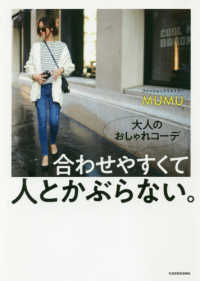- ホーム
- > 洋書
- > 英文書
- > History / World
Full Description
This innovative cultural history of financial risk-taking in Renaissance Italy argues that a new concept of the future as unknown and unknowable emerged in Italian society between the mid-fifteenth and mid-sixteenth centuries. Exploring the rich interchanges between mercantile and intellectual cultures underpinning this development in four major cities - Florence, Genoa, Venice, and Milan - Nicholas Scott Baker examines how merchants and gamblers, the futurologists of the pre-modern world, understood and experienced their own risk taking and that of others. Drawing on extensive archival research, this study demonstrates that while the Renaissance did not create the modern sense of time, it constructed the foundations on which it could develop. The new conceptions of the past and the future that developed in the Renaissance provided the pattern for the later construction a single narrative beginning in classical antiquity stretching to the now. This book thus makes an important contribution toward laying bare the historical contingency of a sense of time that continues to structure our world in profound ways.
Contents
Introduction: Histories of the Future; 1. Experts in Futurity; 2. The Future in Play; 3. Trust in the Future; 4. The Mercantile Vocabulary of Futurity in the Sixteenth Century; 5. The Renaissance Afterlife of Boethius's Allegory of Fortuna; 6. The Emerging of a New Allegory in Mercantile Culture; 7. The Shifting Image of Fortuna; 8. The Separation of Fortuna and Providence; Conclusion: Time and the Renaissance.







